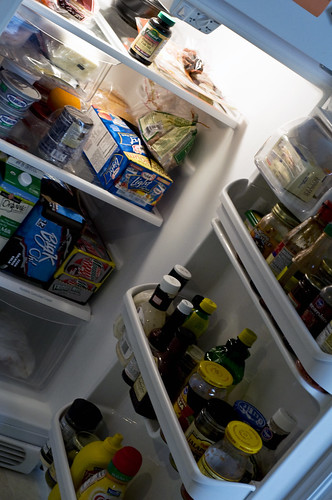
One of my favorite bloggers (Never Home)maker recently endeavored to lower both her grocery bill and budget. She’s not the first. In a recession economy, thousands are looking to save where they can and we’ve seen the revival of spreadsheets and creative lists, as well as new tech tools to help. These are all awesome, but they won’t work long-term unless you have a plan and can successfully make it habit. Two years ago, when Neil and I first endeavored to change the way we were eating, we also wanted to save money while doing it. Our strategy has changed over time, as we’ve become more meat-free and focused on the quality of our food, but there’s a strategy to fit everyone and I hope this little 3-part series over the next week will give you some ideas.
1. Take stock of your stock: The first step in any plan is to figure out where you are and what is wrong. What specific food items or habits are contributing to excess spending? Take this question to your pantry and refrigerator. The first step in cleaning up your act is cleaning and organizing your food storage. Organize your foods in a way that makes them easy to keep track of and easy to inventory at a moment’s notice.

2. Develop your staples list: What items do you use consistently all the time? Categorize these items and make them the base of your grocery list. Organize them in a way that makes sense. I find that using the food pyramid works best.
- Bread, Cereal, Rice and Pasta: Bread
- Vegetables: Carrots
- Fruits: Orange juice
- Milk, Yogurt and Cheese: Milk
- Meat, Poultry, Fish, Dry Beans, Eggs and Nuts: Eggs
- Fats, Oils and Sweets: Olive oil
- Staples, Condiments and Miscellaneous Foods (spices, baking powder, etc.): Mustard
- Health and Beauty Products: Toothpaste
- Household Items (laundry soap, light bulbs, etc.): Coffee filters
3. Accompany Your List with Prices: This step requires a bit more commitment, but if you’re serious and you do it consistently it doesn’t have to be as difficult as you think. Essentially you need to think about where you are spending your money. We all love the organic market or the place with all the gourmet cheeses, but can you really afford to shop there for everything? Take stock of what you’re paying for your items and if time allows you to make multiple trips. Once you’ve figured out what you can and can not afford to pay premium for, figure out what constitutes a regular and sale price for each item. Create a graph and spy on your grocery store over the course of 4 weeks. How often does item X go on sale? You’ll quickly notice that your staple items will be on sale every 4 to 6 weeks.

(above) Pasta and Olive Oil, staples we always stock up on.
4. Learn the “stocking up” approach: We all have embarrassing stories of going to the grocery store with our parents the week they decided to buy the 50-double roll pack of toilet paper right? right?? Once you know the price ranges for your staple items you’ll be able to spot the low prices. When you do, buy 4-6 weeks worth of that item (assuming it’s not produce). Following this method, expect that every week you’ll be stocking up on 1-2 items. The key here is that you’re buying items at their lowest price, not necessarily when you run out. You can often save 50-70% this way. Sure, you may not see huge savings in your week to week receipts, but it adds up over time.
5. Make a Plan: The final step in part 1 is to develop a weekly or bi-weekly menu plan. Fortunately, most grocers now have online ads, making this an easy task to complete before even entering the store. Neil and I shop at Gerbes (Kroger) and the new ad is released every Wednesday morning. Plan your menu and take inventory using the sales flier and you will not only save money, but enjoy the challenge of creating a new menu every week comprised of staples and sale items. Once you’ve completed your menu, it’s time to research your coupons. In addition to traditional newspaper inserts, there are many sites with digital coupons you can print from your home printer. Our standard go-to’s are coupons.com and moneysavingmom.com. The key to using coupons wisely is not printing any that aren’t items on your list (more on this in Part 2).
You’ll notice my advice isn’t specific dollars to cents and what constitutes bad/good budget. As a fellow foodie, I can’t tell you how to spend your money and on what, but I can tell you that endeavoring to save money will require some sort of sacrifice in order to see a savings. For us, this was the line in the sand where we opted to go almost entirely vegetarian during the work weeks. Where we decided to take sandwiches and yogurt for lunch. Where I gave up my weekly Laughing Cow cheese addiction, and Neil reconciled that Cheez-its would be a special occasion snack. These may seem like tiny sacrifices, but they add up over time. They’ve been a huge blessing in disguise as well. What started as an online search for inexpensive recipes and other pseudo-vegetarians and vegans resulted in this blog and so many amazing friends.
Endeavor to start a few of these steps this weekend, and next week stay tuned for Part 2: Shopping, Sales and Markdowns; and Part 3: Greening Your Grocery List
Do you have a grocery strategy? How do you plan your menu? Leave your feedback below!
You may also like







Really great tips! I look forward to parts 2 and 3!